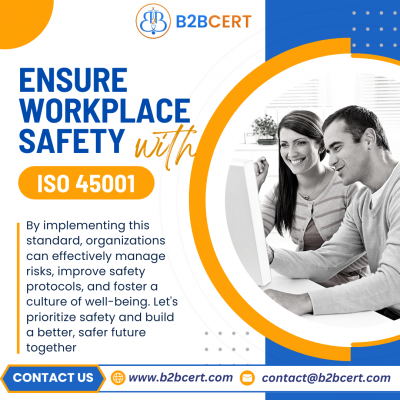Which Standard Does ISO 45001 Replace?
-
When it comes to workplace health and safety, organizations around the world strive to implement systems that protect employees, comply with regulations, and enhance business performance. The introduction of ISO 45001 Certification in Dubai marked a significant turning point in the global occupational health and safety (OH&S) landscape. Many businesses still wonder: Which standard does ISO 45001 replace, and what does this change mean for organizations?
In this blog, we will explore the background of ISO 45001, the standards it replaced, and why its implementation has become a global benchmark for occupational health and safety management.
The Need for a Global Standard
Before ISO 45001 was introduced, there was no single internationally recognized standard for occupational health and safety management. Different countries and industries followed their own guidelines, making it challenging for multinational organizations to align practices across borders.
The most widely used and recognized system prior to ISO 45001 was OHSAS 18001 (Occupational Health and Safety Assessment Series). Though OHSAS 18001 served as a reliable framework, it was not developed by the International Organization for Standardization (ISO). Instead, it was created by a consortium of national standards bodies, certification bodies, and specialist organizations.
This limitation highlighted the need for a truly international standard that could unify health and safety practices worldwide—leading to the creation of ISO 45001.
ISO 45001 Replaces OHSAS 18001
To answer the central question: ISO 45001 officially replaced OHSAS 18001 as the global standard for occupational health and safety management systems.
Organizations certified to OHSAS 18001 were given a three-year transition period (2018–2021) to migrate to ISO 45001. After this period, OHSAS 18001 was formally withdrawn, and certifications under it became invalid.
ISO 45001 not only replaced OHSAS 18001 but also incorporated elements from other existing guidelines such as:
-
ILO-OSH Guidelines (International Labour Organization)
-
Various national standards for health and safety management systems
This comprehensive approach ensured that ISO 45001 became a robust and internationally accepted framework.
Key Differences Between OHSAS 18001 and ISO 45001
While OHSAS 18001 provided a solid base, ISO 45001 introduced several new concepts that strengthened its effectiveness. Some major differences include:
-
High-Level Structure (Annex SL):
ISO 45001 follows the same structure as other ISO management standards like ISO 9001 (Quality Management) and ISO 14001 (Environmental Management). This makes integration across different systems much easier. -
Focus on Risk and Opportunity Management:
Unlike OHSAS 18001, which primarily focused on hazard control, ISO 45001 emphasizes both risks and opportunities. This ensures a proactive approach to workplace safety. -
Leadership and Worker Participation:
ISO 45001 places strong responsibility on top management for OH&S performance. It also emphasizes worker participation in decision-making, fostering a culture of shared responsibility. -
Organizational Context:
ISO 45001 requires organizations to consider internal and external factors affecting health and safety, ensuring a broader, strategic outlook. -
Continual Improvement:
The standard strongly promotes continuous evaluation and improvement of health and safety processes rather than static compliance.
Why ISO 45001 Matters Today
Workplace safety is not just a legal requirement but also a critical factor in employee morale, productivity, and organizational reputation. By adopting ISO 45001, organizations can:
-
Reduce workplace incidents and accidents
-
Demonstrate compliance with global best practices
-
Build trust among employees, clients, and stakeholders
-
Integrate safety with other management systems for efficiency
-
Enhance overall organizational resilience
For businesses in fast-growing regions like the UAE, ISO 45001 Certification in Dubai has become a vital step toward ensuring global competitiveness and compliance with regulatory frameworks.
The Role of Consultants and Services in Dubai
Transitioning from OHSAS 18001 to ISO 45001 or implementing the standard from scratch can be challenging. This is where expert guidance becomes invaluable.
-
ISO 45001 Consultants in Dubai help organizations understand the requirements, design a tailored OH&S management system, and prepare for certification audits. Their expertise ensures a smooth and efficient transition.
-
ISO 45001 Services in Dubai include gap analysis, risk assessments, internal audits, employee training, and documentation support. These services ensure organizations not only achieve certification but also maintain continual compliance and improvement.
With professional assistance, companies in Dubai can streamline their certification journey while focusing on their core business operations.
Conclusion
To summarize, ISO 45001 replaced OHSAS 18001 as the international standard for occupational health and safety management systems. This change was not just a shift in certification but a step forward in aligning global safety practices under a unified, ISO-recognized framework.
By adopting ISO 45001, organizations can protect employees, enhance compliance, and improve overall operational efficiency. For companies in Dubai, partnering with experienced ISO 45001 Consultants in Dubai and leveraging reliable ISO 45001 Services in Dubai ensures a successful and sustainable certification journey.
Ultimately, ISO 45001 is more than a standard—it is a commitment to building safer, healthier, and more resilient workplaces worldwide.
-
